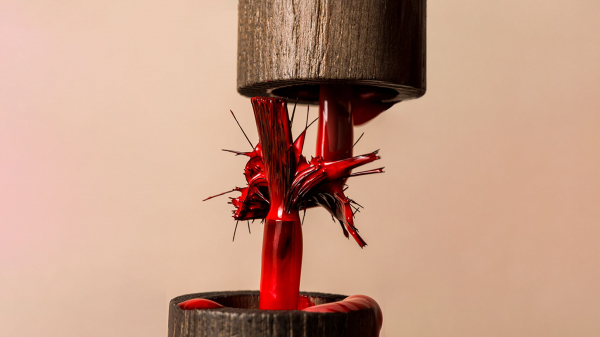 Adobe StockSave this storySave this story
Adobe StockSave this storySave this story
All products featured on Allure are independently selected by our editors. However, we may receive compensation from retailers and/or from purchases of products through these links.
The biggest online beauty discourse of the past two weeks may be known on TikTok as mere “OPI nail drama,” but it’s brought about some pretty philosophical questions about the nail industry. Is it fair for nail technicians to charge upwards of $150 for a set? Is it OK for an untrained person to do their own gel nail polish or extensions at home? What’s worth risking for a free manicure? I’m sorry to say that not all of these questions have definitive answers—but I’m glad we’re talking about it for that exact reason.
Let me go back to the start. On July 8, Chicago-based nail technician Bethany Benigno posted a TikTok that has since amassed nearly five and a half million views. “I never thought we would see the day as licensed nail techs where OPI decided to finally sell out,” she said, shaking her head. “I’m beyond disappointed. I’m so sick of brands basically telling us to go fuck ourselves when we made them what they are.” She was referring to the recent release of OPI’s Gelement Gel Essentials Gel Nail Kit, which comes with nail prep materials, gel base and top coats, and an LED curing lamp for just $60. It’s intended for non-professionals to use at home in tandem with the brand’s new range of Gelement colors, which cost $16 a pop.
Benigno’s comments inadvertently started an uproar between nail technicians and consumers. Many viewers on either side interpreted her message as a woe-is-me sob story that blamed a decrease in business on at-home manicurists who now have access to gel nail polish and the like—and that perceived complaint seemed to have hit a nerve. Suddenly, it seemed like every video on my feed was a consumer criticizing nail techs writ large for overpriced services or limited availability. Things got heated fast. “Why are nail techs saying the words ‘nail tech’ like they’re surgeons?” one TikTok user posited in a video. In another, a user says, “You nail tech bitches really fucked up the industry and you priced yourself out and you let a billion-dollar company fuck with your bag.”
In response, other nail technicians started leaving comments and posting their own videos about whether OPI’s new at-home offerings are a good or bad thing for the industry. Many if not most of them seem totally unfazed by DIY manicurists because, while some people choose to do their nails at home, these licensed manicurists have still found clients who want professional treatment. Techs have even started their own meme of sorts, posting slideshows of their elaborate artworks to showcase the skillsets they’ve acquired through years of training and practice.
Suzie Moskal, a nail technician better known as Nail Career Education online, said of the at-home kit on TikTok, “I’ve been doing this for 40 years; this is nothing new… Talent is what carries you on as a good nail technician, not the product that you’re using.” Another nail artist who goes by the handle NailsByFaithB said, “Anyone can do their nails, anyone can get these products… I don’t care and I never will care.” Even Benigno herself carries this sentiment. I asked her if the use of professional-grade products among consumers has impacted her business or her livelihood at all, and her response was a resounding no. “DIYing has been a thing forever,” she says. “There will always be clients and there will always be DIYers. Some DIYers become clients, some clients become DIYers. That’s just the nature of the business.”
Plus, this is far from the first at-home gel kit, not even from OPI. All the way back in the early 2000s, a now-defunct offshoot of the brand released an at-home gel manicure kit called the Nicole by OPI Salon Gel Manicure, says the brand’s head of global education, Heather Reynosa. It included similar components as today’s iteration of the at-home kit, including a mini curing lamp, prep products, and gel polishes.
So why did Benigno post that video to begin with? As she tells me, “The kit itself is not the issue.” Instead, she’s frustrated that OPI’s at-home gel nail polishes cost less than its pro-only polishes, which cost $18.50 per bottle according to screenshots she provided from the wholesale professional retailer Cosmo Prof (which requires a professional license to access). “All that tells professionals is that [OPI] can sell their products [to us] at a lower rate, they just decide not to.” That’s the point she says she was trying to express in her video, but the internet did its thing and, in my opinion, blew things out of proportion.
I asked OPI about Benigno’s claims that the at-home polishes and lamp cost more than what you’ll see in salons. “Gelement is a smaller size bottle versus the professional GelColor bottle,” Reynosa says (Gelement polishes come in .3-ounce bottles, whereas the pro polishes come in .5-ounce). The kit’s affordability is also due in part to the fact that its curing lamp is built differently from that of a professional’s—Reynosa points out that it’s more compact, so users must cure their fingers and thumb separately. Plus, it only cures for 60 seconds at a time, as opposed to professional-grade lamps that have various timing settings.
Nevertheless, this whole situation has brought some deeply valid industry-wide concerns to light, bringing us to the real problem according to nail techs. Whether they work in a private studio, rent a booth, or are employed by a salon, nail technicians largely pay out of their own pockets for their materials, including polishes, tools, and hygiene and safety supplies—and the costs of these materials, Benigno says, have increased significantly in recent years. Even the most basic of things like nail files and latex gloves, she says, “have tripled in price.” For example, she says she paid, on average $8, for a gallon acetone five years ago but now pays $30. Her prices have risen in tandem with these operating costs; whereas she charged $40 for a gel manicure in 2019, she now charges $60.
Carmen Blake, a technician out of Ocala, Florida, points out that it’s not just the cost of supplies that’s rising for professional nail artists. “Prices of not only nail products but also booth or salon rent, licensing, continued education, cost of booking websites, and cost of advertisement continue to increase constantly,” she says. “The main factor in my prices was that I wanted to make a living wage after paying my booth rent and paying for my supplies.”
This is a familiar tale for pretty much anyone working in any industry right now, and it’s what’s actually impacting the livelihood of nail technicians, Benigno says—not the people who put on gel nail polish at home. “I know several nail technicians who have had to get second jobs to subsidize income, including myself. We cannot thrive if brands are pricing us out of business.”
And that’s the primary reason it’s currently so damn expensive to have a professional paint stuff on your nails or attach fake nails to your real ones. Beningo insists that the prices of professional nail services would come down if those operating costs did, too.
If there’s one thing nail technicians seem to agree on across the board, it’s that they hope people understand the ramifications of using certain products—including gel nail polishes—without the right precautions and application techniques. “I think the main potential issue that could come with gel products being more readily available to consumers is the framing… I think a DIY kit makes it seem very casual,” Blake says. “I fear this could lead to people treating these potentially harmful chemicals with the same care as you would painting your nails with an air-dry lacquer.”
As Allure has previously reported, people can develop serious allergies to gel if it comes into direct contact with their skin over and over again—causing a condition known as contact dermatitis, a type of rash that can be red, itchy, and even painful. That’s because, as Vivian Valenty, PhD, an organic chemist and inventor of the Dazzle Dry Nail System, explained to us in 2023, "Gel products contain two reactive ingredients called monomers and photoinitiators," which "belong to the chemical families called acrylates and methacrylates.” These ingredients are known to be skin sensitizers, which means that if they're accidentally absorbed into the skin, it can cause an allergy. (And anyone who’s ever tried a DIY manicure of any type knows that your first or second or 50th attempt will likely result in some polish making contact with the skin around your nail.)
Blake thinks DIY manicurists are capable of great work; that said, she is still concerned for their health. “I worry that larger brands making DIY kits more available for the average uninformed consumer will only contribute to [a rise in contact dermatitis among nail hobbyists].” Benigno concurs, offering advice to DIYers: “Make sure you’re buying the appropriate LED/UV lamps, curing for the appropriate time, and keeping product off the skin before curing.”
Reynosa says OPI is aware of this risk and has developed educational services—such as Geliversity, its range of online tutorials where professionals demonstrate gel nail polish techniques—for its at-home products in response. Additionally, “Robust testing has been done to ensure that, when used as directed, the Gelement line is a safe and sufficient at-home solution to getting a gel manicure,” Reynosa says. If you are doing a gel manicure at home, use a small nail brush or Q-tip dipped in acetone remover to get rid of any rogue polish before you cure it under the light.
As an untrained but relatively knowledgeable person who does her own gel manicures regularly (and has even written the guide on how to use the Gel-X system at home), I personally can’t judge if people largely ignore the potential for disaster and find themselves with a painful rash and a potentially lifelong allergy to gel nail products. It could possibly happen to me one day, and that’s a risk I know I’m taking every time I bust out my curing lamp instead of calling my local salon. But I, too, feel strapped for cash while simultaneously feeling societal pressure to look as “put together” as possible.
So I understand why this powder keg of consumer frustration about the price of nail services has exploded; it’s been sitting in a corner waiting to blow for a long time now. But if you ask me, the anger directed at nail technicians is widely misplaced. There seems to be an impression among the average salon-goer that nail technicians charge such high prices because they’re greedy—and I’m sure, just as there are in every industry, there are at least a few people who are acting in bad faith—but in reality, many of them are just trying to stay afloat. “Everyone cares about money because we have to. This isn’t greed, it's people caring about if they are going to be able to pay rent,” Blake says. “Which makes service providers frustrated to be told that their prices are too high when they can't even afford to have three meals a day.”
And in response, the people who want to see a professional feel, as Blake puts it, “gatekept from services they feel they deserve when they can't afford to have three meals a day, either. So everyone's just hungry, broke, and not sure what they are mad at, but know they are mad.” This discourse is a vicious cycle that has yet to land on a helpful or empathetic conclusion.
Whether we as the consumers can afford to have a regular nail appointment or have learned how to do our own nails to save money, we should all be pointing our frustration at the economic strain that makes nail services more expensive for everybody. (It’s worth noting that non-professional nail products are also more expensive than they used to be—just about everything is.)
Besides, the DIY nail community as we know it wouldn’t exist without professional nail techs—they’re the ones who showed us how to do it all in the first place. If you’ve ever Googled gel nail polish application tips or the best cuticle remover or tutorials on a trendy nail art look, you owe more to techs than you may realize. You might see them as the reason you can’t afford to go to the salon, but they’re also the reason your nails can still look nice regardless.





